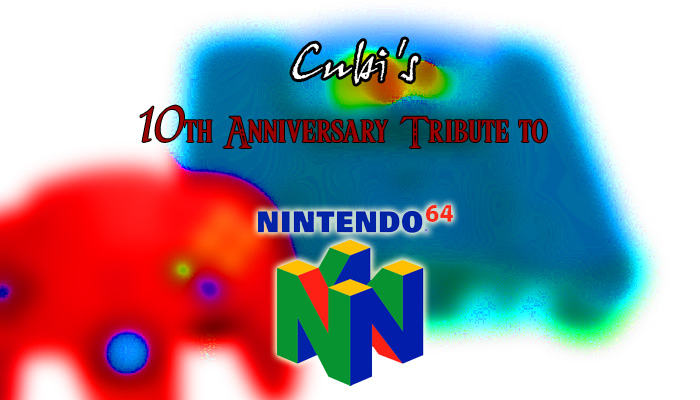
The Nintendo 64. Released 1996 in NTSC markets and in 1997 in PAL territories, it was Nintendo’s first fully 3-D console. Made as a successor to the super popular and industry-defining SNES, the N64 saw in its 5 years Nintendo’s fall from the top of the home entertainment market. Sony, who created the PlayStation from the ashes of the to-be collaboration with them and Nintendo to make a CD platform for the SNES, used the design of this new platform to create the next new most successful console ever. Sony didn’t only bring in the CD platform to the industry successfully and en masse for the first time, it also hosted numerous reiterations of old franchises that practically reinvented their lines. Games like Final Fantasy VII or Metal Gear Solid were parts of older franchises that once belonged to Nintendo’s “side”. New games like Resident Evil, Pro Evolution Soccer, Crash Bandicoot, Tekken and Gran Turismo quickly geared the PlayStation for hardcore and casual gamers alike, with the latter term practically being invented by Sony’s generation. Nintendo’s decision to build its console around the ’80s philosophy of cartridges paid its tolls; even though N64 games had non-existant loading times and were pretty resistant to wear and tear (both factors compared to Sony’s CDs), not only couldn’t they fit 1/10 of what CDs could fit, they were also much more expensive to produce and, for good or for bad, much more difficult to duplicate, using legal means or otherwise. Yes, the possibility of pirating games and playing copies only really kicked off with the PlayStation and many would argue that this is one of the basic factors for its appeal to the broad audience. Cool games for cheap. What more could a bloke ask for? But I digress. This post has little to do with how the PlayStation changed the face of the games industry.
Way back then, in 1997, I didn’t know and I didn’t particularly care about these things. My mother had bought me my SNES for my 8th birthday, which was when I essentially became a Nintendo gamer. I did own a pseudo-NES on which I had numerous classic games of the NES era, among them Super Mario Bros. and Bubble Bobble, but my pre-SNES gaming history is also irrelevant. By 1997 of course, SNES was as new as PS2 is today alive and kicking. OK, PS2 is still selling better than PS3, but that’s not the point here! I had found myself a console that was dying, with N64 coming right around the corner. Neither me nor my mum knew that at the time, but it wouldn’t take long for me to find out (meanwhile I enjoyed such wonderful games as Yoshi’s Island, Donkey Kong Country 3 or Super Mario All-Stars that were already defining my gaming profile.)
July 1997. By now I’ve caught wind of the existence of N64, but I’ve been too busy playing SNES to really care. Suddenly, one day, I get to play Super Mario 64 in a small toy shop in Eisenstadt, Austria. I stand there, jaw hitting floor. I start playing on the demo stand for hours at a time, and the shopkeepers always shooed me away in words I didn’t understand every time it was time for the shop to close… I urged my mother to let me go to the shop again and again or to any other shop that had the game so I could play, even if I played the wrong way, holding the left handle of the middle one (I didn’t even know there was a Z button). It was just sooo good! I had even made her buy me a strategy guide of it in german and pestered her every time to translate bits and pieces to me… Sorry mum! 😛 There was no way around it: that console and that game had to be mine.
The rest of the summer and autumn went by with me wanting a Nintendo 64, fantasizing about it (you know, going to school and thinking about it and stuff) and really looking forward to Christmas. That’s when mum had told me she’d get it for me… Agonizingly, and with me playing some more SNES games, Christmas 1997 finally was upon us. Christmas Eve to be exact. It was a sunny morning, and I was playing Super Mario World while the other children were out singing the Kalanta. That was the day we’d go and get it (yeah it was much less dramatic than the Nintendo 64 kid scene, no trees, no wrappings or anything. But it was cool in its own way) So we did, from that big shop in Kallithea mum used to refer to as “the warehouse (apothiki)” and which later became Max Stores. That’s where we bought most of my SNES games as well. I got my N64 along with Super Mario 64 and GoldenEye. When I got home that day, I connected the system to our small 14″ Grundig I used to play my SNES on and played for hours. We’d have Christmas with friends, and so all the family friends came and brought their kids as well, and we all gathered round the TV and played… I remember Kostas’ and Alex’s faces, they couldn’t believe I had it! 😀 And the next day, (Christmas Day) another sunny morning, I called my then best friend Kostas (it was another Kostas) and we played together… Well with one controller it was much less “playing together” than “letting Kostas watch me play and maybe handing him the controller for a few turns” but that’s how it goes sometimes! GoldenEye didn’t get much playtime at first cause I couldn’t figure out how to play it… That, of course, soon changed…
Anyway, If I wrote ALL of my experiences with the little machine down it’d make for some tall wall of text, so my intro stops here. Intro, because I’m just getting started! This Christmas 10 full years will have passed since the day that was a landmark for my gamer side. As a tribute to those days and to the N64 which I think is (ok nostalgia really talking here but that’s how it works usually, right?) one of the best consoles ever, I’ll post my Top 20 for it, along with any comments, thoughts or experiences from and about each game. So, let me take you back to the past, back to my childhood days…
20. Pokemon Stadium
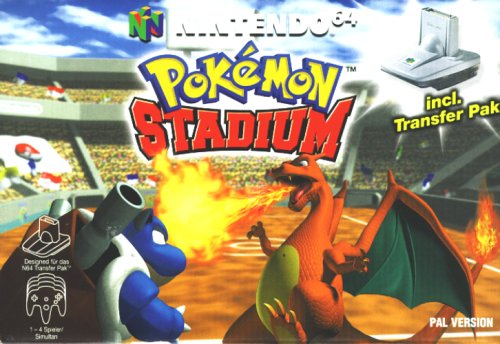
The year is 2000. Pokemon mania is sweeping the West and every pre-teen boy can’t help but succumb helplessly to the charm of Game Freak’s Pocket Slaves. While Pokemon Blue/Red were released in Europe in late 1999, I first got involved in the huge phenomenon around January of Y2K. The whole thing intrigued me very much, noticing but not really observing the craze that had followed not only the game but also the anime series on TV. It especially hit me when I went to Austria that year. Pokemon was EVERYWHERE!
I quickly made up for any lost time with some vigorous playing on the Game Boy. I played and played Pokemon Blue for hours on my green GB Pocket… I’m somewhat embarrassed to say that Pokemon was my first RPG, and so it was some really fresh material for me. I quickly understood that I shouldn’t only be leveling up my Venusaur leaving my Paras and Pidgeotto at Lv ~20, and deleted my game and started anew once or twice so that I could have a really balanced team and finally get the game mechanics. I was hooked, just like any other 11-year-old at the time. But I wanted more. And I knew that my Nintendo 64 had the key to that.
April 2000. After some months of agonizing wait (I still remember how frantically I looked for the game in all the stores I frequented… Once I even remember getting to the verge of tears after a big disappointment from my local game shop, when they told me that they didn’t know when it would be released), I skipped school and waited for mum to call me from Jumbo and tell me that she had finally got it. Oh BTW, even since then I somewhat organized skipping school with mum, she always was good like that. Or wait… Maybe I was malingering again and she just played along with it, I don’t remember… She wasn’t too strict about that kind of thing and as we can see today no harm came from it. 😛 Anyway, she brought the game home and I was DELIGHTED I can tell you! Popped it in my N64, put my Pokemon Blue in the Transfer Pak so I could use my Pokemon from the Game Boy game in Stadium, and off I went!

The game, while it lacked any RPG mode, had some meat. It was certainly cool looking at your hardy monsters in magnificent 3-D, reading the new Pokedex entries Stadium had, playing the Game Boy game on the big screen through the Transfer Pak or even giving the mini-games a go. Lickitung’s Sushi Bar was a good laugh, as well as another one with Electrode in which I don’t remember what you had to do… All these mini-games were multiplayer, and good thing I had some friends that also were into the whole Pokemon thing. OK, I’ll admit it, I was the nerdier one when it came to games… But Stadium’s best feature was none other than multiplayer battling. We used to play with rentals, looking for quick duels of skill in commanding the little bastards. The game really was ideal if you wanted a quick dose of the rush of a Pokemon battle without having to plunge into the depths of the RPG.
While I also bought Pokemon Stadium 2 when it came out and generally liked it and the second generation Pokemon, the first game made a much bigger impact on how we played with our monsters back then. It was the next best thing after the GB games and it surely deserves a spot in my Top 20.
19. Turok: Dinosaur Hunter
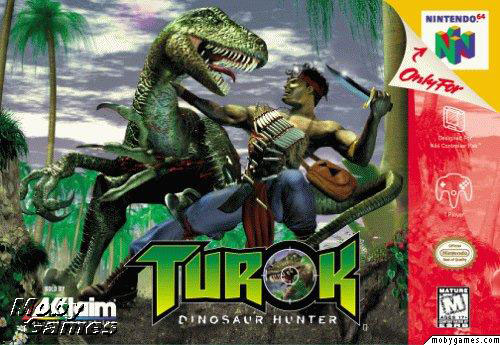
Turok, if I recall correctly, was a whim purchause I made with dad. We looked for a present for me and it ended up being Turok. I have no idea when, but it happened!

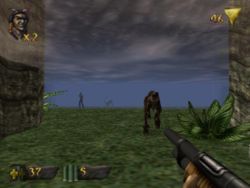 The hero was an indianesque person that hunted dinosaurs becauuuuse… Again, I have no idea. I didn’t ever get much into the game’s story. The only things I can tell are: the game was hard, it had some cool and biiig guns and some interesting locales, the game was confusing, and its cheats were superb! Unlocking the uber guns and blasting everything away certainly was fun, as was being invincible and flying (I still remember that the cheat code had something to do with “bird”… But that is as far as my memory serves me), and going to every boss stage and wooping ass. Because I ended up only playing the game using cheats because I thought it was much better using some cheat or another than just playing normally, not to mention much less frustrating, I don’t remember it at all well. But messing around with this game was rewarding! Plus, how cool is a game full of dinos? Even if sadly you have to kill them… Looking back, the “normal” game must have been good, at least its structure was hub-based and linear at the same time. Intriguing, no?
The hero was an indianesque person that hunted dinosaurs becauuuuse… Again, I have no idea. I didn’t ever get much into the game’s story. The only things I can tell are: the game was hard, it had some cool and biiig guns and some interesting locales, the game was confusing, and its cheats were superb! Unlocking the uber guns and blasting everything away certainly was fun, as was being invincible and flying (I still remember that the cheat code had something to do with “bird”… But that is as far as my memory serves me), and going to every boss stage and wooping ass. Because I ended up only playing the game using cheats because I thought it was much better using some cheat or another than just playing normally, not to mention much less frustrating, I don’t remember it at all well. But messing around with this game was rewarding! Plus, how cool is a game full of dinos? Even if sadly you have to kill them… Looking back, the “normal” game must have been good, at least its structure was hub-based and linear at the same time. Intriguing, no?
18. Banjo-Tooie
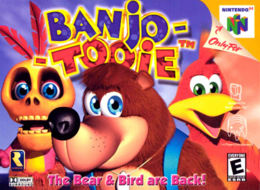
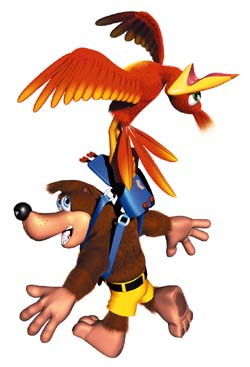
Banjo-Kazooie ranked very high in my top games for a long period of time (still does) and my expectations for the sequel were even higher. B-K’s ending revealed that “Banjo-Tooie” would allow the player to gain access to hidden secrets in the original game by means of using a stop ‘n’ swap kind of system, something to do with cartridge swapping anyway. This in my mind only meant that Banjo-Tooie would have an awful lot to do with the original, and I just couldn’t wait!
Banjo-Tooie was released in Europe in June 2001. When it appeared, I had exams (it was the end of my first year in junior high) so I couldn’t pick it up right away. But when I did, I couldn’t help but be a bit disappointed. I found out that the “stop ‘n’ swap” thingie had been dropped and that only a few connections remained with Banjo-Kazooie, like the appearance of Gobi the camel or other references that should have been dependant on your status in B-K. The real secrets of the original were lost forever (even though lots of hackers are still tearing the cartridge apart to find hidden connections and clues, check out the numerous YouTube videos on this) and were replaced by the same items that the connection would have unlocked but had been hidden quite normally within the game.
Apart from this diasappointment though, Banjo-Tooie was actually pretty good. The worlds were much larger than those of the first game, more transformations, there were connections between levels, the graphics were better, the music was of the same high quality and generally it was a pretty worthy sequel to the first adventure of the bear and bird. Rare also once again showed what a great sense of humour they had throughout this game with their typical style of never ever taking anything too seriously. Unfortunately, unlike the first one, I only played through Banjo-Tooie once and did not even collect all of the jiggies. Thus, my memories of the game are pretty limited. I do remember some special moments, like the T-Rex transformation, Cloud Cuckoo Land and the Jinjo Village. I’d like to play it again some day, if only to make it more vivid in my mind.
17. Pokemon Snap

Another Pokemon title in the Top 20 (and it’s the last one). This time it has nothing to do with battles or collecting monsters… It’s all about…
PHOTOGRAPHS!
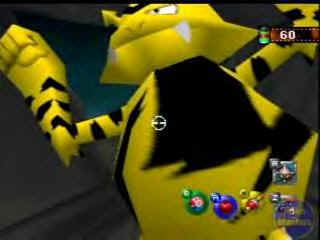 In Pokemon Snap you go around on-rail levels like caves, beaches, volcanoes etc and take pictures of Pokemon in their natural habitat. Professor Oak then scores your pictures according to the size of the Pokemon in the picture, its stance, if the Pokemon is using a special move, how interesting or impressive the picture is etc. Interaction with the Pokemon is accomplished through the use of pester balls (throw one at it and see what happens) and apples (which inexplicably all Pokemon like) and a lot of the time a mini-puzzle has to be solved for a Pokemon to forget its camera shyness or even appear at all. Sometimes, Prof. Oak judged pictures on wrong criteria, and a fine, rare and artistic picture could go down the drain… Right? No! The game allowed you to save a fairly lare number of pictures… You could have a very personal Pokemon photo album!
In Pokemon Snap you go around on-rail levels like caves, beaches, volcanoes etc and take pictures of Pokemon in their natural habitat. Professor Oak then scores your pictures according to the size of the Pokemon in the picture, its stance, if the Pokemon is using a special move, how interesting or impressive the picture is etc. Interaction with the Pokemon is accomplished through the use of pester balls (throw one at it and see what happens) and apples (which inexplicably all Pokemon like) and a lot of the time a mini-puzzle has to be solved for a Pokemon to forget its camera shyness or even appear at all. Sometimes, Prof. Oak judged pictures on wrong criteria, and a fine, rare and artistic picture could go down the drain… Right? No! The game allowed you to save a fairly lare number of pictures… You could have a very personal Pokemon photo album!
Even if the game becomes predictable after a while because of the linear actions the player has to take to capture the best poses of each Pokemon (which is still not always the case, some Pokemon really allow for creative photographing), it still manages to be addictive and FUN! This game might actually be one of the best-executed spin-offs ever, and I owe that to HAL Labs, who’s behind this… Game Freak wouldn’t be able to pull this off! Anyway, capturing wild Pidgeys flying around in flocks in one picture, a Scyther slashing away or Mew dancing through the air in its bubble surely never felt this good. Sadly, the game only features about 60 out of the (then) 151, but it’s not a big deal since all have their cries straight from the anime and are actually very well modeled. In some cases I think their Snap renditions are better than in Stadium… Anyway, this game is a must for any friend of Pokemon and it’s not hard to understand why I loved it back in October 2000, when I really was a pretty hardcore fan.
TO BE CONTINUED







 The hero was an indianesque person that hunted dinosaurs becauuuuse… Again, I have no idea. I didn’t ever get much into the game’s story. The only things I can tell are: the game was hard, it had some cool and biiig guns and some interesting locales, the game was confusing, and its cheats were superb! Unlocking the uber guns and blasting everything away certainly was fun, as was being invincible and flying (I still remember that the cheat code had something to do with “bird”… But that is as far as my memory serves me), and going to every boss stage and wooping ass. Because I ended up only playing the game using cheats because I thought it was much better using some cheat or another than just playing normally, not to mention much less frustrating, I don’t remember it at all well. But messing around with this game was rewarding! Plus, how cool is a game full of dinos? Even if sadly you have to kill them… Looking back, the “normal” game must have been good, at least its structure was hub-based and linear at the same time. Intriguing, no?
The hero was an indianesque person that hunted dinosaurs becauuuuse… Again, I have no idea. I didn’t ever get much into the game’s story. The only things I can tell are: the game was hard, it had some cool and biiig guns and some interesting locales, the game was confusing, and its cheats were superb! Unlocking the uber guns and blasting everything away certainly was fun, as was being invincible and flying (I still remember that the cheat code had something to do with “bird”… But that is as far as my memory serves me), and going to every boss stage and wooping ass. Because I ended up only playing the game using cheats because I thought it was much better using some cheat or another than just playing normally, not to mention much less frustrating, I don’t remember it at all well. But messing around with this game was rewarding! Plus, how cool is a game full of dinos? Even if sadly you have to kill them… Looking back, the “normal” game must have been good, at least its structure was hub-based and linear at the same time. Intriguing, no?


